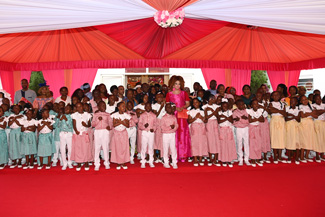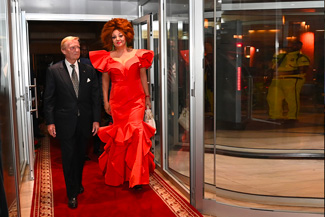 When he was sworn in for the first time on November 6, 1982, Paul BIYA focused his attention on the democratization of the political landscape, social and economic liberalisation, rigour and moralisation and the reinforcement of international cooperation ties.
When he was sworn in for the first time on November 6, 1982, Paul BIYA focused his attention on the democratization of the political landscape, social and economic liberalisation, rigour and moralisation and the reinforcement of international cooperation ties.
The new Head of State decided to rest his power on the most organised political system in the past, the former one party system: Cameroon National Union (CNU). He was elected President of the Party on the September 14, 1983. He later on organised an anticipated Presidential Election and was elected President of the Republic in January 1984. He was re-elected in April 1988 and in October 1992. The 1992 election was the first ever Presidential Election that was based on universal direct suffrage with many candidates, in the history ofCameroon. In November 1997 and October 2004, he was elected President for a seven year mandate.
Paul BIYA, therefore, decided to speed up political reforms in a bid to resolutely leadCameroon in the part of modernism, democratisation, and the participation of a large number in the decision making process. In March 1985 he revitalised the CNU, during a memorable congress that held in Bamenda, reorganized its structures and renamed it the Cameroon People’s Democratic Movement (CPDM). He encouraged his countrymen to develop interest in politics and to freely air out their views.
This situation did not need much to spark off initiatives of all sorts even within the CPDM. Paul BIYA later explained that “the name Cameroon People’s Democratic Movement (CPDM) was not a mistake. Indeed, it first of all refers to an assembly of all citizens of good will, without any exception, who hold the unity and stability of our country in high esteem. It also refers to democratising the political landscape of our society, which no doubt had its merits at one point of our national history that appeared to be stagnant. It refers, over and above all, to the consolidation of the people’s sovereign power so that they can better participate in the management of State affairs. These are objectives that the CPDM was bent on gradually attaining. First, to apply the rules of pluralism, then grant freedom of speech to the masses so that they could air their views. Therefore, before the wind of change started blowing across Africa, we had already begun the democratisation process”; "the wind of change”, which the Head of State referred to stimulated the birth of all types of political parties in 1990. Even though the first opposition parties were not recognised and legalised until February 1991, 1990 marked a turning point in the democratisation process in Cameroon. That same year, Cameroondefinitely opted for a pluralist democracy. This was the result of a job done in an organised, tactful and ideal manner by Paul Biya after his accession to power on the November 6, 1982. His experience as Head of State enabled him to consolidate his democratic achievements (pluralist elections, modern constitution) and to carry out reforms of the State. In addition, peace and unity were maintained or better still reinforced.
Architect of Liberalisation
The driving force of President Paul Biya’s policy since his accession to power was the hallmark of the liberalisation of the Cameroonian society. Under his regime, Cameroonhas witnessed peace, liberty and political stability. Democracy is now common place. Elections are democratic, free and fair. The idea of liberalisation was clearly expressed in June 1991 in the people’s choice: “Slowly but steadily, we have liberalised and democratised our nation. All laws that aimed at attaining individual or collective freedom were completely annulled or amended. We have instituted multiparty politics. Freedom of speech and of the press are guaranteed”. This process of political modernisation is translated by the setting up of institutions that ensure the separation of powers and the security of individual rights through the January 18, 1996 constitutional amendment, the promulgation of the new Criminal Procedure Code that takes into consideration the rights to defend and to be presumed innocent.
The advent of political freedom was both in theory and in practice: The President proudly reaffirmed that in Cameroon, “there is no longer the need to delegate high ranking officials to express ones ideas”. For example, till date, we can count 197 political Parties which, since 1990, freely carry out their activities. In December 2000, considering public opinion, the National Elections Observatory (NEO) was created. In November 2006, after a series of consultative meetings, many civil society organisations reflected on modernising the new method of conducting elections. This resulted in the creation of Elections Cameroon (ELECAM) in 2008.



















